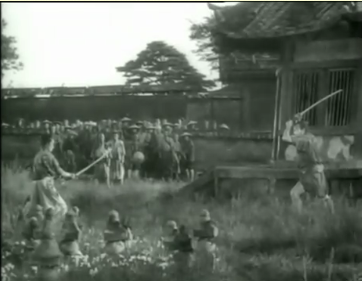
SEVEN SAMURAI (1954, Kurosawa)
This film has yielded so much influence, from Lucas’ space operas to Leone’s macaroni westerns (as, fittingly, the Japanese referred to them). And today’s shot is just one breathtaking moment from the old master, Akira Kurosawa, in a film packed with them.
If you can’t remember this moment, or haven’t seen it yet, it’s best you watch the clip first. Mea culpa – the only high-quality youtube I could find is in Italian… but you don’t really need to know what is being said.
[youtube=http://www.youtube.com/watch?v=JCXhHOEWZfA&feature=related]
.
So, wow, right? The shot, I’m sure you’re onto, is at 3:06, and what a startling and amazing use of slow motion to create a moment of tremendous suspense, surprise, and dramatic weight. Even today, in a time when slow motion has been used to death, this moment is still utterly original and fresh, in my opinion.
Kurosawa’s Dynamic Samurais
This shot works in no small part due to the amazing sound design. Less is certainly more here – you could hear a pin drop after that flash of violence. A flurry of fearsome activity followed by absolute stillness – visually and audibly. The suspense is so beautiful. And this shot and scene couldn’t be more dynamic – loud and then silent, fast and then slow, brutal and then graceful – and therefore couldn’t be more compelling.
And what’s more, I don’t even think this is best use of slow motion in the film – there’s one even better – but it’s not on youtube. I plan on posting it myself, which will give me an excuse for another Seven Samurai post!

Jeremy Cole
Now you’re talkin! This really is great. Such a show of how powerful the fundamentals are. As you pointed out, you really don’t need to know what’s being said and that’s a great compliment to the old sensei’s film syntax. I love the way he has the other samurai watching/comparing the stomping and screaming; the aggressive posture with the quiet, graceful, yielding posture — the way it’s cut to show us.
It also made me think about the power that the dry run with sticks brings to the scene (coulda gone straight to swords). How it highlights ego at play, how the fact that it’s a replay builds tension and shows how small the margin is (we couldn’t see it) between victory and death. How skilled and centered this guy is. That’s a lot to communicate!
3ricshane
Japanese art is really about the negative space vs flashes of color/action. (Think: Zen garden) Even the tableau of the grassy field focuses the eye on the actors, with the wall ending on the victor. Someone once explained music to me as “tension and release”, and this scene is very “musical” in that way.
jsbfilm
Hear, hear!
Robbie
Good stuff. I still remember how I felt after watching this film for the first time. I think I know what’s coming next.
jsbfilm
Thanks for posting, Robbie. It’ll be great to see if we’re thinking of the same moment!